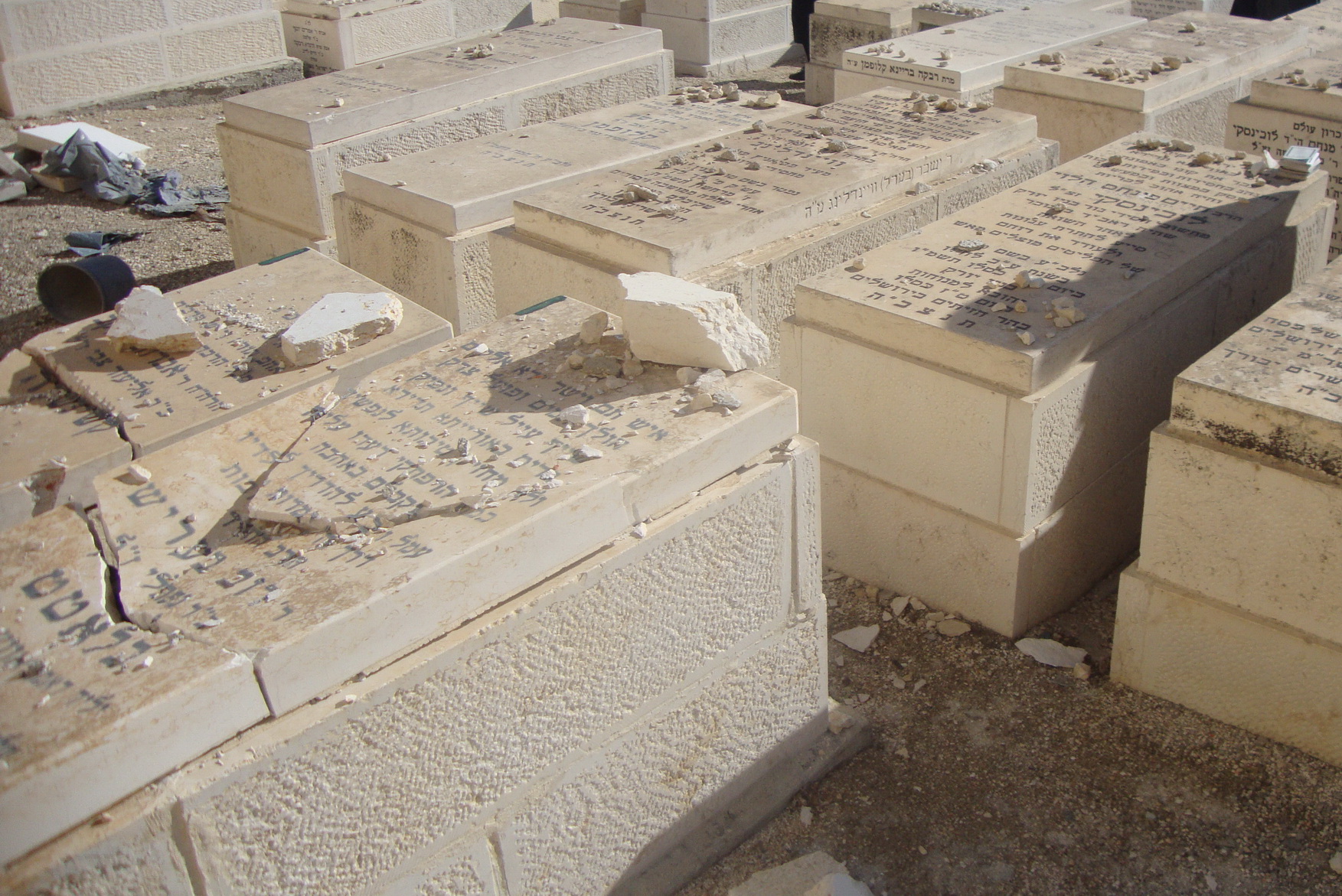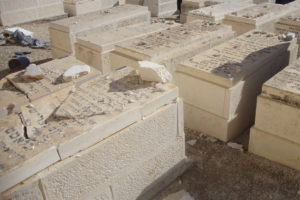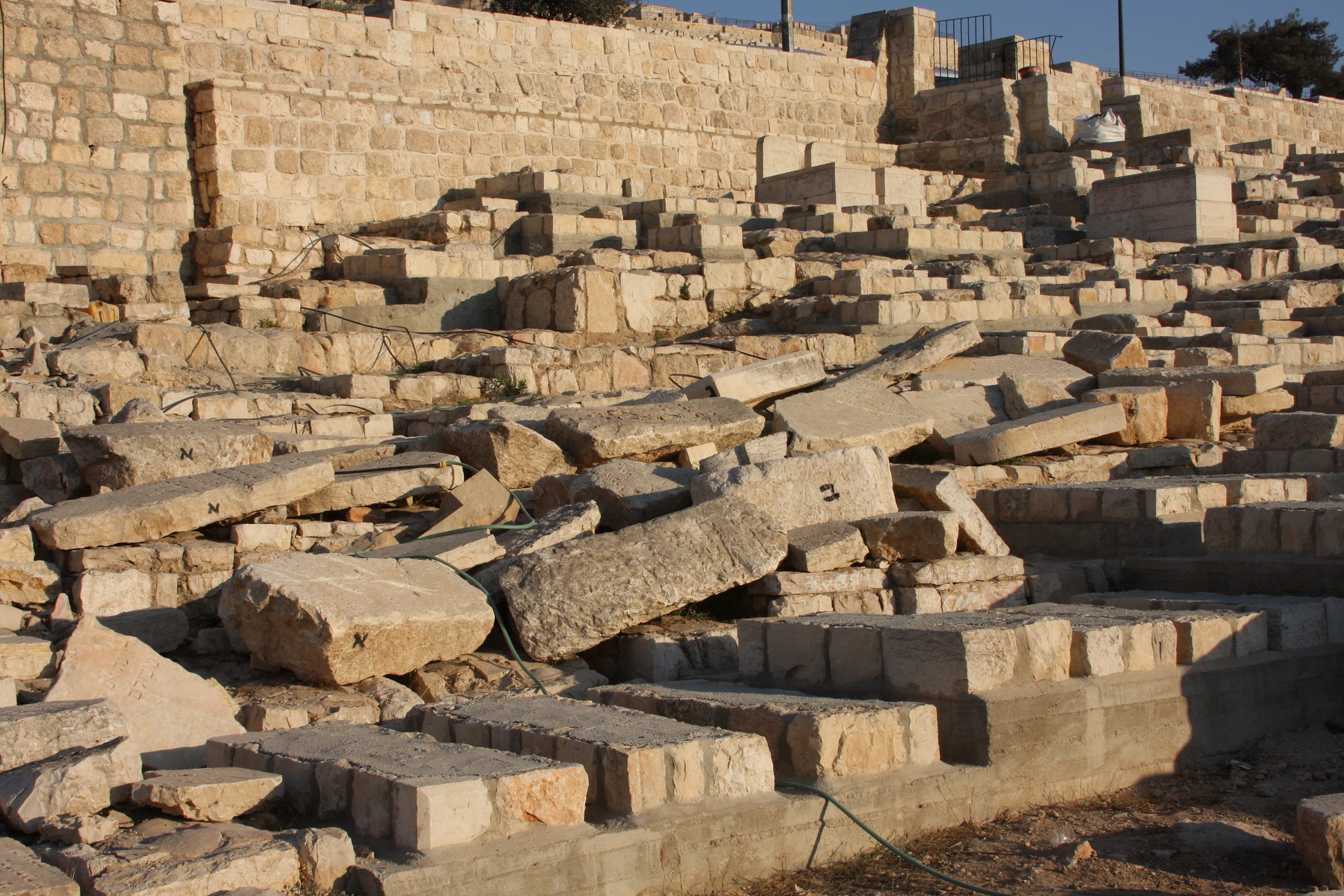It was to say the least a disturbing sight on a bright Sunday morning on Har Hazeisim in Yerushalayim. As I turned to say Kaddish marking the yahrzeit of my father (Harav Chaim Pinchas Lubinsky zt”l), I faced an entire row of destroyed kevorim, apparently by boulders hurled from above. The scene on a level just above where my parents lie was one of more destruction, including hollow gravesites with their matzeivos strewn about. Although the area was repeatedly targeted by Arab hooligans, it is the first time that it came so close to the graves of my parents. Turning away from the kevarim were Arab houses, one with a newly posted flag of Hamas. (I learned later that Hamas was on a flag campaign in East Jerusalem.) In fact, during an earlier tour of nearby Arab neighborhoods with Ateret Kohanim, some of it in an armored jeep, I noticed several Hamas flags, perhaps on par with the number of Palestinian flags.
The destruction that had apparently occurred a month or so ago, explained the officials that I subsequently met with, was because there was still no coverage by the rapidly growing number of surveillance cameras being installed on Har Hazeisim, thanks to the efforts of the International Committee for Har Hazeisim, headed by its founder Avrohom Lubinsky (my brother). While some 80 of a planned 137 cameras were already in place, 60 were functioning with the others still undergoing tests. Officials promised that within a few weeks some of the additional cameras would be installed on the Kollel Polen section as well as the area that includes the maareh where three rabbeyim of Ger lie, also frequently targeted by Arabs.
In the newly built fortified command center with its high tech monitors, three security agents monitor the screens 24/7 for any signs of abnormal activity. Just last week, the camera captured an Arab in his late 20’s sitting on a step and conversing on a cellphone. He soon rose, moved over to a nearby grave, and labored to push a headstone to a nearby valley where it shattered in pieces. Obviously preparing for his next act of wanton destruction, the security people in the monitoring station summoned the Har Hazeisim security team who within minutes pounced on the thug, holding him until police arrived. In early December, he was sentenced to 3 months in prison. What was perhaps most disturbing is that he told investigators that he was paid NIS 1000 by the handler with whom he had apparently been conversing prior to perpetrating his act. The police were ostensibly investigating who the handlers were.
As I toured Har Hazeisim, I found some areas completely covered by many cameras while other areas like the Kollel Polen section were only sparsely covered. While officials promised additional cameras, it is unclear that even after all the cameras are installed that the huge sprawling mountain would be entirely covered, but officials guessed that more than 75% would be seen by the cameras. Significantly some of the new cameras that are installed are advanced models with day and night infrared capabilities and others are thermal cameras that detect body heat.
An important piece of the security puzzle will be filled in when a police garrison finally begins functioning on Har Hazeisim in addition to the small private security force that these days provides mostly escort services to visitors and mourners. The committee is working with officials on details of such a deployment that includes both short-term and long-term logistical planning.
The no-nonsense policy pursued by the incoming new police leadership in Jerusalem, headed by Niso Shaham, will hopefully have a positive effect on security on Har Hazeisim as well. Police are dealing harshly with any signs of disturbances in neighboring A-Tor, Silwan, and Ras al Amud, significantly reducing violence in the area. This is significant since it will mean better security for those visiting Har Hazeisim. Avrohom and members of the committee feel that they have turned the corner on security but make no secret of the many challenges that still lie ahead.
15,000 Graves Restored; 60,000 to Go
In the Kidron Valley, not too far from Yad Avsholom, tractors were busy clearing debris from large areas, under the close supervision of Gadi, a private frum contractor hired to supervise the effort, and assisted by the Chevra Kadisha. Using maps from the Chevra Kadishas that go back to the early 20th century (and perhaps well before that), Gadi’s team does the painstaking work by hand of clearing every kever. If a partial matzeivoh is by chance found, an effort is made to complete the matzeivah. Most of the matzeivahs were used to build the roads leading to the Inter-Continental Hotel built by the Hashemitte Kingdom in the 1950’s. Instead of honoring the 1948 Armistice they signed allowing access to the cemetery, they perpetrated the largest mass destruction of graves in history without ever compensating the families or the Chevra Kadisha to rehabilitate those graves. What Gadi tells me next is most shocking. “I believe that there are still 60,000 more graves that have to be rehabilitated,” he says. If he is correct, it would mean that the Jordanians destroyed 75,000 graves, a number impossible to imagine and probably unprecedented in history, including the Nazi period.
I wondered out loud whether it would be possible to somehow locate the families to erect a proper matzeivah, but the records only mention the name of the niftar. I admired the tenacity that Gadi showed and his deep commitment to kovod hameis. Officials of the Prime Minister’s Office and the Jerusalem Development Authority who accompanied me on the tour promised to step up the effort and to also fund the infrastructure of new pathways and gating to preserve the newly rehabilitated graves.
Stalemate at the Mosque
For weeks, the committee has been hard at work to stop the expansion of the Ras al Amud Mosque just feet from the gravesites of many luminaries, including the late Prime Minister Menachem Begin and his wife Aliza as well as prominent rabbonim. The mosque is also just around the corner from the main (and only) parking lot to Har Hazeisim. What was a small mosque years ago was slowly becoming a major structure at the mouth of the 3000-year old Jewish cemetery. It was clear from documents that the mosque was illegally expanded. Some municipal documents clearly delineate the area as zoned for a cemetery. Pressure by the committee resulted in a Stop Order and the police confiscating building materials.
But here and there reports were received that despite the Stop Order, construction continued. Committee leaders are asking that the extension be torn down and sealed but officials made it clear that it was unlikely that they would tear down a mosque in the current political climate.
To my utter surprise, a senior police official accompanied me, two leaders of our Israeli committee (Jeff Daube and Harvey Schwartz) and an official of the Jerusalem Development Authority to the area where the mosque stands. As we pulled up in the armored police van, the sergeant went ahead to gain the permission to visit the mosque from the elders, with whom he apparently had a relationship. They greeted us courteously, albeit with obvious suspicion and perhaps disdain. We entered in front of where the original mosque stood with its wall to wall blend of colored Persian rugs and other carpets. We walked past the illegal extension with its rooftop of red Spanish tiles that I am still not clear when it was done (I heard anywhere from a year and a half ago to as much as 10 years ago). Somehow that extension had gone by without notice. Then came a room that was used to wash hands and feet in advance and after prayers. There seemed to be about dozen faucets for each. This was followed by a space with construction material and then we turned the corner to walk to the back where we saw the latest expansion. It extended from the back of the red roofed structure to just three feet from the low wall where many graves jutted out. The roof seemed to have a newly paved concrete top and the posts for the obvious next step: final installation of a red roof to match the structure in front of it.
The room inside was locked, explained the elders because there were some thefts, including money from the charity boxes. Through a crack, I was able to notice a room that was largely undone with a mound of dirt and some construction material. They, in fact, suggested that we build a fence atop the wall with barbed wire to separate the cemetery, a favor to us, they said, but the real purpose was clearly to keep vandals out of the mosque. So what was this expansion all about?
We learned that on an average Friday, as many as 600 men from Ras al Amud converge on the mosque with cars parked all around Har Hazeisim, including the parking lot. “If we know that there is a levayeh,” said the police official, “we make sure to restrict access to the parking lot.” Although I was amazed that the space could hold 600 men, I was quickly reminded that this was not an area with benches and tables but a place where 600 men prostate themselves on rugs in very close cramped conditions.
So the expansion, explained the elders and the police, was to build more “showers” (faucets for the hands and feet) and they graciously agreed to remove the small room that is now the site of the faucets. Be as it may, this expansion adjacent to the cemetery was unacceptable, despite efforts by officials to minimize the scope of the project and to keep raising the political sensitivities.
The police say that they are planning to permanently station a van to assure that construction does not continue. The Waqf continues to apply for official permits which the municipality will most likely reject. A classic standoff? Yes, except that the committee refuses to accept this as fact and will mobilize public opinion.
Much to Be Done
Perhaps the most gratifying statement (and in a way sad) was when the officials plainly said that the accomplishments to date would not have happened were it not for the committee. Referring to Avrohom, a senior official said: “See what a Jew from Brooklyn can do.” They acknowledged that it wasn’t Avrohom alone, but the persistence of people like Malcolm Hoenlein, Executive Vice Chairman of the Conference of Presidents of Major American Jewish Organizations, and even the courage of Prime Minister Benjamin Netanyahu who became the first Israeli Prime Minister since 1967 to take on the enormous challenge of securing Har Hazeisim. Also singled out for praise were the officials in the PMO as well as in the JDA and the Municipality.
But Avrohom and members of the committee have no illusions as to the enormous task that lies ahead. In addition to the completion of the installation of the cameras and the deployment of the police, there is still no definitive word on a budget for 2012 and beyond to continue the work. There are still many points on Har Hazeisim that need to be gated to keep undesirables out. The surrounding areas leading to Har Hazeisim have to be more secure, perhaps with cameras and additional police, to assure safe access to the ancient cemetery. The mosque remains blight on the holiest Jewish cemetery in our history. There is the enormous task of cleaning up Har Hazeisim, posting signage at the graves of the Nevi’im and other luminaries such as the Orach Chaim Hakodosh and the many rabbinic leaders and Chasidic rebbeyim who are interred there. Regular Egged bus service must be restored and Har Hazeisim once again recapture its majesty from the days of the Bais Hamikdosh. And then perhaps Moshiach will give us all a pat on the back for what we’ve done!






